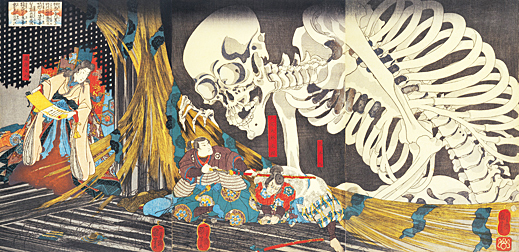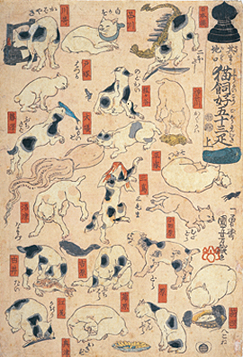 |
Focus features two in-depth reviews each month of fine art, architecture and design exhibitions and events at art museums, galleries and alternative spaces around Japan. The contributors are non-Japanese art critics living in Japan. |
|
|
 |
 |
 |
Imagination Is Funny: The Ukiyo-e of Utagawa Kuniyoshi
Christopher Stephens |
 |
 |
| He Looks Fierce but He's a Really Great Man (c. 1847) |
Running through June 5 at the Osaka City Museum of Fine Arts, the Kuniyoshi: Spectacular Ukiyo-e Imagination exhibition provides one of the most extensive collections of work by the wondrous Edo Period artist Utagawa Kuniyoshi. Timed to coincide with the 150th anniversary of the artist's death, the event is made up of some 400 prints, which are scheduled to be displayed in two separate phases, with the first 200 on view until May 8, and a second, completely different set of 200 works going up on May 10 and continuing until the end of the show.
Born to a dyer in the Nihonbashi district of Edo in 1797, Kuniyoshi's talents were recognized early when he was accepted as a pupil in the Utagawa school of woodblock printing at the age of twelve. The school nurtured an array of ukiyo-e masters, including Hiroshige (1797-1858) and Yoshitoshi (1839-92), but unlike the former, whose forte was the landscape, and the latter, who specialized in the grim and grotesque, Kuniyoshi is best remembered for his charming, witty imagery.
Kuniyoshi made a name for himself with a series of portraits depicting the 108 outlaws (105 men, three women) of the Water Margin, a 14th-century Chinese literary classic that was enjoying great popularity in Japan at the time. While unquestionably dynamic and colorful, these early works lack the warmth and unique spirit of the artist's simpler later prints. In time, Kuniyoshi left these warriors and mythic heroes behind and began to branch out into other areas, with pictures of beautiful women, children, landscapes, and sideshows, all of which were common enough motifs but not often attempted by a single artist.
 |
Princess Takiyasha Calling up a Monstrous Skeleton Specter at the Old Palace in Soma (c. 1845-46)
|
It was in the humorous medium of giga (caricatures), however, that Kuniyoshi truly excelled -- particularly in his superb renderings of animals, some of which were stand-ins for famous actors and courtesans, or satirical portraits of government figures. In one work, a group of orange-and-white goldfish girls walk fin-in-fin with a small frog in tow, fanning themselves and singing seasonal songs on a hot summer's evening. In another, a procession of foxes -- led by a group of torch-bearers walking upright, then gradually evolving into slightly more human creatures clad in ceremonial kimono, and finally, reverting to full vulpine characteristics -- makes its way in the moonlight along the shore of a lake shouldering a palanquin, which presumably contains a bride on the way to her wedding. Most striking of all, though, are Kuniyoshi's tanuki (raccoon dogs), an animal famed for its abnormally large testicles and often found in ceramic form outside Japanese restaurants. Taking this legend one step further, the artist shows a group of tanuki fishermen scooping their catch out of a small pool of water in their boss' huge scrotum, which they are standing around and stretching out like a net. In other prints, tanuki scrotums double as drums, blankets, or kotatsu tables. Perhaps most revealingly, they are also depicted as unnecessary appendages that simply weigh their owners down as they trudge through the street with the heavy sacks draped over their heads.
Kuniyoshi is especially renowned for his visual games and trick art. Among these are illustrations for handheld fans in which the silhouette of what seems to be a bat or a snail is visible through closed shoji screens on one side but is revealed to be a cluster of people or cats striking bizarre acrobatic poses on the other. The artist also constructed portraits out of tiny curved and intertwined human bodies that immediately recall the work of the 16th-century Italian painter Giuseppe Arcimboldo, whose own subjects were composed of things like fruit, vegetables, and flowers (whether Kuniyoshi had access to reproductions of Arcimboldo's paintings is unclear). Kuniyoshi also seems to have had a particularly sharp eye for feline mannerisms, as displayed in his catalogue of 53 cats engaged in, for the most part, typical behaviors (curled up on a cushion, making off with a rat or fish, slipping in or out of a basket) that function as verbal puns on the names of each station along the Tokaido highway between Edo and Kyoto.
This exhibition is that rare thing -- an event that is sure to please everyone, regardless of their age or ethnic background, the degree of their knowledge of or interest in art, or their familiarity with Japanese history and culture. And as with major retrospectives of other Edo greats like Ito Jakuchu (1716-1800) and Kawanabe Kyosai (1831-89) over the last few years, one is astounded by the sweep of Kuniyoshi's imagination and the eternal appeal of his vision.
 |
|
 |
| Singing "Bonbon" Song (c. 1842; Series: Set of Goldfish) |
|
Fifty-three Cats as Puns for the Names of the Stations on the Tokaido Road (c. 1848)
All works shown are by Utagawa Kuniyoshi; images courtesy of the Osaka City Museum of Fine Arts
|
|
 |
 |
Christopher Stephens
Christopher Stephens has lived in the Kansai region for close to 25 years. In addition to serving as the editor of the now defunct magazine Kansai Time Out for many years, he has extensive experience as the translator of numerous exhibition catalogues for museums throughout Japan, and art and architecture books such as What's Gutai?, The Architecture of E.G. Asplund: 1885-1940, Salon to Biennial, World Architects 51, Miwa Yanagi: Windswept Women, Tomoko Konoike's Inter-Traveller, and Tadanori Yokoo's Tokyo Y-Junctions. |
|
 |
|